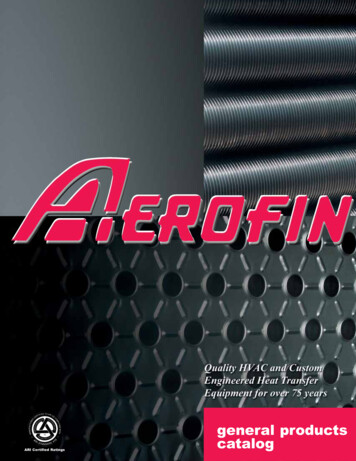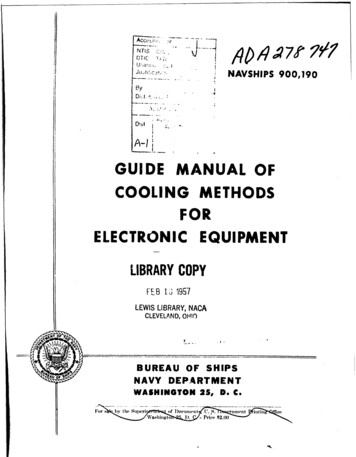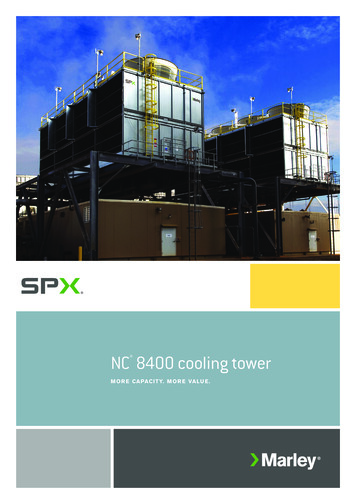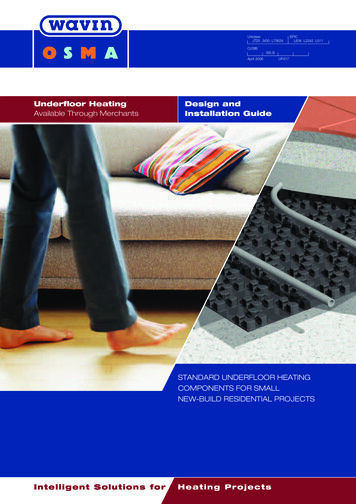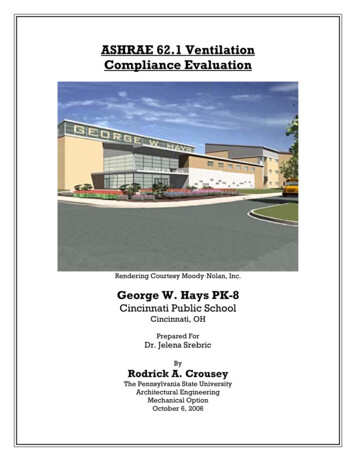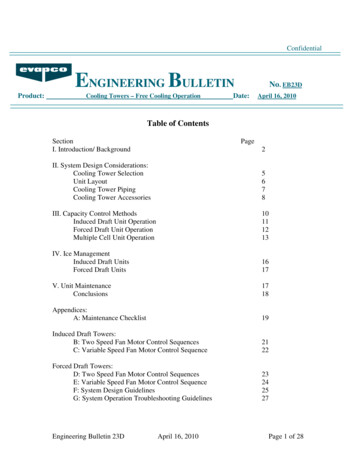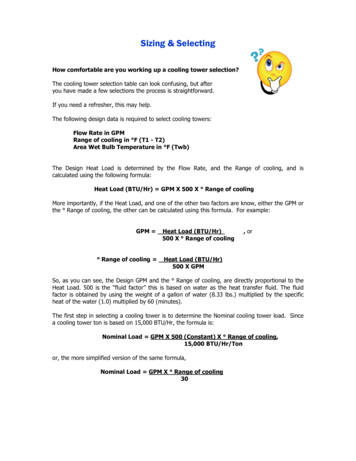
Transcription
413STEP4PERFECT HEATING, COOLING, AND VENTILATIONYour home will keep you comfortable under all weatherconditions. We designed the structure to keep you comfortablewith a minimum of energy. However, the structure can’t always dothe job alone. In most climates, it needs help from equipment thatthe construction industry calls “comfort systems.” These systemsperform heating, ventilation, and air conditioning, so they are alsocalled “HVAC systems.”mos.ckoBoToday, the HVAC industry offers a daunting menu of equipmentchoices. Fortunately, we can narrow the choices to two heating andcooling combinations that are best for most homes. We will decidewhich one is best for you. Then, we will explain the critical featuresof your system so that you can make sure that it is installed flawlessly.ygerEnAfter that, we select special heating and cooling equipment forcertain rooms. We learn how to provide cooling at low cost by usingventilation, and in some locations, by using evaporative coolers. Wedesign the ventilation throughout the house for health and odorcontrol. And, we select the most effective and economical methodsof controlling humidity.If you are renovating an existing house or just replacing wornout equipment, your best choices usually are the same as for a newhouse.
420Step 4 Perfect Heating, Cooling, and VentilationSU PER H O U SEENERGY COST WORKSHEET(Since we are working with an accuracy of only twosignificant digits, we should round off these estimatesto 8 per million BTU for natural gas, 28 per millionBTU for fuel oil, and 18 per million BTU for heatpumps.)Comparing these three energy sources, we see thatnatural gas would be your most economical source ofheating energy, if it is available. If natural gas is notavailable, you probably would select heat pumps if theclimate is temperate enough for them to work well.You would select fuel oil only if the climate is too coldfor satisfactory operation of heat pumps.Don’t base any major decisions on small differencesin these numbers. If the differences in cost betweenyour energy options are small, it is more important tofocus on the likely trends of these costs in the future.Step A: Convert all energy prices to the same units.For:multiply dollars perelectricitykilowatt-hournatural gastherm293 10 970 cubic meter27 U.S. gallon7.2 liter27 U.S. gallon11 liter32 .05 (variable) .045 (variable) cubic footNo. 2 fuel oilpropanecoalto get raw cost in per million BTUbyU.S. tonmetric tonneStep B: Calculate the end-use energy cost.multiply raw costby1 high-efficiency heat pump inmild climate0.3 high-efficiency heat pump inclimate with extended warmand/or cold season0.4 to 0.7 0.4 to 0.6 1.4 1.1 microwave oven1.8 high-efficiency condensingboiler, furnace, or water heater1.1 good non-condensing boiler,furnace, air heater, or waterheater1.3 gas range2.5 gas oven1.1 No. 2 fuel oilhigh-efficiency, non-condensingboiler or water heater1.3 coalwell designed hydronic boiler orfurnace1.6 to 2.5 For:electricityused inelectric resistance heater orwater heaterheat pump water heaterconventional electric rangeelectric ovennatural gas andpropane/LPGto get final cost in per million BTUEnTo get energy prices for your home site, contactlocal energy suppliers. These include the local electriccompany, the gas company, propane suppliers, and fueloil dealers, as appropriate. There may be more than onesupplier for each source energy. If so, get prices fromseveral retail suppliers.For electricity, be aware that most electric utilitiesadd charges to your monthly bill, in addition to the costof the electricity itself. This raises your average cost.Also, electric utilities offer discounts for special termsof service. For example, see the sidebar, Two Ways toLower the Cost of Electric Water Heating, in Step 5.For a broader perspective, you can get regionalprices from the Internet. In the U.S., the EnergyInformation Administration (EIA) maintains a Web sitethat gives regional prices for all major energy sources.The EIA Web site also provides historical prices, whichare useful for perspective on how the costs of differentenergy sources have been changing.moc.skooyBgreWhere to Find Energy PricesNow, you are able to decide which heating andcooling systems are best for your home. Next,we will learn how to design the two majorrecommended heating systems, hydronic systemsand split-system heat pumps.If a hydronic system is not the best choice for your home, skipthe following explanation of hydronic design and go to theexplanation of heat pump design that follows it.R421
430Step 4 Perfect Heating, Cooling, and VentilationSU PER H O U SEHydronic Radiators and Narrow ConvectorsIn much of the world outside North America,hydronic heating is done with convectors that are tallerand narrower than American baseboard convectors.Figure 4‑15 shows a typical example. Commonly, theseare made of one or more hollow flat plates, in which thehot water is circulated. However, a convector can havealmost any shape, as long as it has sufficient surfacearea.Such units are commonly called “radiators,” eventhough they function primarily as convectors. They doemit some heat by radiation because their outer surfaceis exposed to the room.The capacity of a hydronic radiator is limited bythe low temperature at which it must operate to avoidcreating a burn hazard for the occupants. Also, if a unitis mounted somewhat high on a wall, it cannot suck thecold air layer from the floor and warm it.Certain styles of hydronic radiators can provideheating in rooms where baseboard convectors wouldnot be practical. In particular, they are the mostappropriate kind of hydronic heater for shower roomsand toilet rooms. Figure 4‑16 is a typical example.Hydronic radiators usually are made of paintedsteel, which rusts quickly in the presence of waterand urine. If you want to install hydronic heating ina wet space, try to find a unit that is made of corrosionresistant material.Some manufacturers offer models that areespecially elegant in appearance, so they can be used asan element of decor. For example, the fancy hydronicradiator in Figure 4‑17 also serves as “towel warmer.”Hydronic Fan-Coil UnitsDRWFigure 4-16. Hydronic radiator with a self-containedthermostat, installed in a toilet room in Germany. Theheat from the radiator tends to turn off the thermostat,so response is slow and temperature control is crude.moc.skHydronic Floor HeatingHydronic floor heating circulates heating waterthrough tubing that is embedded in the entire floorsurface or that is attached to the underside of the floor.In this way, the surface of the floor becomes the roomheater.Floor heating can be installed in concrete slabs andin wood frame floors. It can be installed under tile,hardwood, and dense synthetic materials, such as vinyland linoleum, all of which conduct heat adequately.Despite claims to the contrary, it is not prudent toinstall floor heating if the surface will be covered withcarpets, carpet pads, or extensive rugs, all of whichinsulate the room from the floor heating system. Theheat from the water tubing should be able to reachthe visible floor surface without overheating the floormaterial itself.Floor heating is often called “radiant” heating,which is incorrect. The water coils warm the floorby conduction, and the floor then warms the bottomlayer of air in the room – and occupants’ feet – byconduction. Finally, the warmed air rises into the spaceby convection. Radiation from the floor is minor, and itprimarily warms the ceiling. Where to Use Hydronic Floor HeatingooyBgrneEAs the name implies, a “fan-coil” unit is a heatingunit that consists of a coil and a fan. It is mounted in anenclosure that has an outlet at the top and an inlet at thebottom. The finned coil is folded within the enclosureto provide a large heating area, and the fan forces alarge volume of air through the coil. As a result, a fancoil unit has a large heat output in relation to its size.Figure 4‑18 shows a typical unit.Fan-coil units presently are uncommon in singlefamily homes. They require an electrical connectionin addition to the plumbing connections. They have acertain amount of fan noise, and the cabinets take upwall space. Still, consider fan-coil units for spaces thatneed to be warmed quickly and for spaces that needa lot of heat output from a small unit. For example,you might install one in a home office that is packedwith furniture that would interfere with baseboardconvectors.Some fan-coil units are designed to be installed inan equipment closet. This kind of unit heats an adjacentroom through a short duct and a grille.If you install more than one fan-coil unit in a roomor zone, pipe heating water to each unit separately.Hudson ReedFigure 4-17. A fancy hydronic radiator that is commonlycalled a “towel warmer.” The unit has limited surfacearea. When it is covered by a towel, its heat emissionis further reduced.A hydronic radiator can be made in virtually any shapeinto which tubes can be bent.Heavier units should be supported by the floor, butmany newer models are light enough for wall mounting.Similarly, the water connections can come through thefloor or through the wall.Figure 4-18. An attractive hydronic fan-coil unit.DRWFigure 4-15. Typical hydronic room heater, inGermany. The front face of the unit heats largely byradiation. In addition, the multiple vertical passagesprovide considerable heating by convection.431MestekThere are few applications in typicalhomes where floor heating provides acompelling advantage over other kinds ofhydronic heating. As a rule, floor heatingmay be an option to consider for certainindividual spaces, not as a primary methodof heating your home.For formal rooms, one advantage offloor heating is that it is completely invisiblein the room, except for the thermostat. Itcreates no physical or esthetic interferencewith furnishings. Also, it is completelysilent, a benefit that it shares with convectorsand radiators.Floor heating provides good comfortin rooms with tall ceilings because it tendsto cancel stratification. The advantage isgreatest if the room is poorly insulated. Inyour home, that would occur only if youchoose to build a special room that has a lotof glass. (See What If You Want a Space withLots of Glass?, in Step 2.)Bathroom floor heating is a deluxeapplication that is more expensive thanother methods of warming a bathroom. Theheating is very pleasant, and it helps to dry
456SU PER H O U SEStep 4 Perfect Heating, Cooling, and VentilationHow Heat Pumps and Air Conditioners WorkHow Heat Pumps and Air Conditioners WorkAs its name implies, a heat pump is a devicethat moves heat, rather than converting heat fromsome other energy source. Typically, 50% to 80%of the heating energy that is delivered to the insideof a house by a heat pump is taken from the outdoor environment, where it is free.Normally, heat flows from a region of highertemperature to a region of lower temperature. Ifyou hold a flame under one end of a metal rod, theheat will flow from the hot end toward the cool end.In the same way, during cold weather, indoor heatflows through the structure of a house toward theoutside.The unique characteristic of a heat pump is itsability to make heat flow in the opposite direction,from a cooler region to a warmer region. In a manner of speaking, a heat pump “pumps” heat uphill toward a higher temperature, against its normaltendency.HOT GASHow does a heat pump perform this magic?Figure 4-36 shows a simplified heat pump. It usesa substance called a “refrigerant” that circulatesbetween the inside and the outside of the house.The refrigerant changes from a liquid to a vapor,or vice versa, in different parts of the system.The process absorbs heat from the cold outside airand delivers that heat to the inside of the house ata higher temperature.A heat pump exploits two facts that you mayremember from chemistry class. One fact is thatcompressing a gas (or vapor) makes it hot, andletting a gas expand makes it cool. The otherfact is that it takes a lot of energy (called “latentheat”) to change a liquid to a vapor. Conversely, the vapor gives up that same amount of heatwhen it condenses into a liquid. A refrigerant isa material that has a large latent heat, and it canchange from liquid to vapor within the operatingtemperature range of the heat pump.EXPANSION ORIFICECOLD LIQUIDCOLDGAS(2) A fan blows house air through the insidecoil, which warms the air and cools the refrigerant vapor. As the vapor cools, it condenses intoa warm liquid, giving up its large amount of latentheat and providing most of the warmth. The liquidrefrigerant drains to the bottom of the coil.(3) The liquid refrigerant is forced through the“expansion valve” by the discharge pressure of thecompressor. The expansion valve is a small orifice that is located at the inlet to the outdoor heattransfer coil.(4) The outdoor heat transfer coil is at lowpressure because it connected to the suction sideof the compressor. At the outlet of the expansion valve, the liquid refrigerant encounters thislow pressure. This causes a fraction of the liquidto flash into a vapor. The reduction in pressuremakes the vapor cold. At the same time, the evaporation absorbs a large amount of energy from theremaining liquid, making the liquid colder than theoutside air.moc.sk(5) The liquid and vapor flow through the outside heat exchange coil. A fan blows outside airthrough the coil. The outside air is warmer thanthe very cold refrigerant inside the coil, so heatflows from the outside air into the refrigerant. Thehigher outside air temperature causes the liquid refrigerant to change to a vapor, absorbing alarge amount of latent heat from the air.(6) The refrigerant vapor flows to the comp ressor, and the cycle repeats.COMPRESSORWARM LIQUIDINSIDE(WARM)(1) The compressor compresses the refrigerant vapor, making it hotter than room temperature.The compressor discharges the vapor to a heattransfer coil located inside the house.ooyBgrneELet’s start at the compressor in Figure 4-36,and follow the refrigerant as it flows through theheat pump:OUTSIDE(COLD)DRWFigure 4-36. A simplified heat pump. This heat pump extracts heat from the outside air and moves it into thehouse. Most real heat pumps can move heat in both directions, so they can provide both heating and cooling.457A heat pump needs electricity to operate thecompressor, the fan for the inside coil, and the fanfor the outside coil. The compressor uses mostof the energy. The compressor’s need for energyincreases along with the difference in temp er a turebetween the inside and the outside. Therefore, aheat pump will use more energy to heat a houseduring cold weather than it will during mild weather.Also, the heat pump’s heating capacity dropsas the temperature difference increases. Belowa certain temperature, the efficiency and capacity of the heat pump drops so much that it cannotoperate effectively. For this reason, ordinary heatpumps are not used in very cold climates.The simplified heat pump in Figure 4-36 movesheat only from the outside to the inside. Most realheat pumps include a “reversing valve” that canswap the connections of the compressor to the inside and outside coils. In this way, the heat pumpcan either heat or cool the house.The electricity used by the compressor ultimately becomes heat inside the refrigerant. Thisheat is delivered to the warm side of the system,along with the free energy that comes from thecold side. For this reason, a heat pump is more efficient when heating a house than when cooling it.An “air conditioner” is a heat pump that is designed only to pump heat from the inside of thehouse toward the outside. It lacks a reversingvalve. Other than that, there is little difference inconstruction between an air conditioner and a heatpump, and little difference in manufacturing cost.
486Step 4 Perfect Heating, Cooling, and VentilationSU PER H O U SEOther Kinds of Evaporative CoolersEvaporative Coolers for Dry ClimatesConventional air conditioning cools by the sameprocess that is used in your refrigerator. “Evaporativecooling” is a much older kind of cooling that can be usedin dry climates. It uses less energy than refrigerationcooling, and the equipment is less expensive. If youlive in a dry climate, don’t overlook this option.Before we get into the details, you should knowthat evaporative cooling is inferior to conventionalair conditioning in all respects except its lower energycost. It is unlikely that you will want it as the primarycooling for your house. If you travel in the AmericanSouthwest, where evaporative cooling is common,you will see restaurants and bars advertise that theyare “cooled by refrigeration” to reassure potentialcustomers that they don’t use evaporative cooling.Even if evaporative cooling is not the best choicefor the main part of your home, you may want to useit for spaces where temperature and humidity are lesscritical, such as a glassed-in veranda.Several kinds of evaporative coolers have beendeveloped, but only one is presently popular for use inhouses. Specialists call that kind “direct” or “singlestage.” Everyone else simply calls it an “evaporativecooler” or “swamp cooler.”How Evaporative Cooling WorksThe common type of evaporative cooler ismechanically very simple. Figure 4‑65 shows how itoperates. A fan blows outside air into the house througha large hole, which may be a window, a wall opening,or a roof opening. A wetted curtain or pad surroundsthe fan intake. The outside air is pulled through the wetpad by the fan on its way into the house. A small pumpcirculates water over the pad to keep it wet.The machine is packaged in a housing that isinstalled outside the house. Figure 4‑66 shows apreferred method of installation.Although the equipment is simple, the way it worksmay not be obvious. Several processes are happeningat the same time: Entering air evaporates some of the water in the pad. The evaporation cools the rest of the water in thepad. The entering air is cooled by contact with the pad. The moisture that evaporates from the wet pad goesinto the entering air stream, increasing its humidity.The air is coolest where it enters the house from theevaporator. The air picks up heat and becomes warmeras it travels through the house. The air exits from thehouse, usually through one or more open windows.An ordinary evaporative cooler is a once-throughsystem. The air cannot be recycled for further coolingbecause its moisture content is too high. The exhaust aircarries away the water that is introduced by the cooler.Also, the exhaust wastes any cooling that remains inthe air.Unlike a heat pump or air conditioner, theevaporative cooler does not take heat energy out ofthe entering air. Instead, it trades temperature forhumidity. This trade can make a person comfortableonly if the temperature and the humidity of the enteringair are both low enough. And thatdepends on the climate.The biggest disadvantage of a conventionalevaporative cooler is the excessive humidity that it maycreate inside the house. A combination of coolness anddampness is not comfortable, and it invites mildew.AdobeAirFigure 4-65. Direct evaporative cooler. This is thesimplest and most common kind.The higher humidity created inside the house byevaporative cooling can promote mildew and structuraldamage, and it may rust steel tools and other implements.As a rule, it is not prudent to use evaporative cooling forany part of a house that tends to remain cooler or morehumid than the rest of the house. This would includebasements, bathing spaces, and the laundry area.Among engineers who work with evaporativecooling, the simple kind of evaporative cooler that wejust described is called a “direct” evaporative cooler.Other designs have been developed to minimize thehumidity and efficiency limitations of direct coolers.The improved designs use a “heat exchanger.”The air inside the house is recirculated through theheat exchanger, and the heat exchanger is cooled byevaporating water. In this way, no humidity enters thehouse, and none of the cooling effect of the evaporationis wasted. These designs have names like “indirect,”“2‑stage,” and “hybrid.”As this is being written, these improved evaporativecoolers for houses are still a rarity, and they areexpensive. If they become more available, they areworth considering.Climates for Evaporative CoolingEvaporative cooling is limited to climates that aredry. Only dry air can evaporate water strongly enoughto create the desired cooling effect.Evaporative coolers are commonly called “swampcoolers.” However, they won’t work at all in a swampyclimate. Instead, they may turn the inside of yourhome into a swamp if you operate one in weather thatis not dry. In that case, the cooler simply acts as a hugehumidifier, which invites indoor condensation andmildew.The hotter the climate, the drier the outside airmust be in order for evaporative cooling to work.As a realistic example, let’s assume that you want toachieve an indoor temperature of 78 F (26 C). At thistemperature, the maximum relative humidity for goodcomfort is about 60%. The following table showsthe outside air conditions that must exist in order foran evaporative cooler to create those desired indoorconditions:moc.skooyBgreEn487If the outside airtemperature is: F ( C)the outside relativehumidity must beless than (%):80 (27)5085 (29)3890 (32)2995 (35)23100 (38)16105 (41)11110 (43)8Figure 4-66. Evaporative cooler installed through thewall of a house. This location is superior to the morecommon roof installation because the entering air iscooler and access for maintenance is easier. Do notinstall through a window.These numbers* show that the climate mustbe very dry in order for an evaporative coolerto provide good comfort in a hot climate. If theclimate is not dry, an evaporative cooler cannotapproach the standard of comfort that is providedby mechanical air conditioning because the air willbe too humid.On the other hand, evaporative cooling may stillprovide a welcome improvement over no cooling at all.For example, large portable spray coolers have becomepopular for cooling large tents used at public events,even in climates that are not ideal for evaporativecooling.* Beware of performance numbers that are published bypromoters of evaporative coolers. Such sources mayassume that the air inside the house is allowed to rise to100% relative humidity. That would be very uncomfortable,and it would grow mildew. You don’t want high relativehumidity inside your house under any circumstances.
appropriate kind of hydronic heater for shower rooms and toilet rooms. Figure 4-16 is a typical example. Hydronic radiators usually are made of painted steel, which rusts quickly in the presence of water and urine. If you want to install hydronic heating in a wet space, try to


